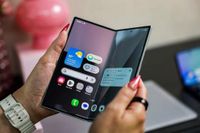Samsung Electronics has been making waves in the smartphone market this year, setting new records and redefining consumer expectations with its latest foldable devices and upcoming releases. The Galaxy Z Fold7 and Flip7 series, launched in July 2025, have not only shattered pre-order records in South Korea but are also gaining unprecedented traction across global markets including the United States, India, and Europe.
In South Korea alone, these foldable smartphones recorded a staggering 1.04 million pre-orders during their reservation period, surpassing the previous record of 1.02 million units held by earlier foldable models. This surge in demand signals a significant shift in consumer interest towards foldable technology, which until recently had been considered a niche segment.
India, the world’s most populous country, surprised the industry by selling 210,000 units within just 48 hours of pre-orders. This rapid uptake led Samsung’s Noida factory to ramp up production to meet the unexpected demand. Meanwhile, Europe, traditionally a challenging market for foldables where such devices accounted for a mere 1.5% of smartphone sales last year, experienced a 50% increase in pre-orders compared to the previous model. This growth is remarkable, especially given the continent’s historically conservative stance on foldable phones.
Perhaps most notably, the United States market, home to Samsung’s fiercest competitor Apple, has shown a 25% rise in pre-order sales year-over-year for the Galaxy Z Fold7 and Flip7. The Fold7 model, in particular, achieved its highest sales ever among the Fold series in the U.S., underscoring Samsung’s dominance in the foldable category ahead of Apple’s anticipated entry into this space next year.
Industry experts attribute much of this success to Samsung’s meticulous design improvements. The Galaxy Z Fold7 boasts a thickness of just 8.9mm, which is surprisingly close to the 8.2mm thickness of Samsung’s flagship bar-type smartphone, the Galaxy S25 Ultra. Considering the Fold7’s foldable nature, this is a remarkable engineering feat. Additionally, the Fold7 weighs 215 grams, making it lighter than the S25 Ultra’s 218 grams. This reduction in bulk and weight addresses one of the foldable phones’ biggest consumer concerns: their traditionally hefty feel and thickness when folded.
Daniel Araujo, Senior Vice President of Samsung Electronics’ MX Business Division, highlighted these advances during the company’s second-quarter earnings announcement. He said, “The latest 7th generation foldable products, Galaxy Z Fold7 and Z Flip7, are thinner and lighter with innovative camera performance, wider cover screens, and optimized One UI Foldable software, receiving very positive customer responses.” He further emphasized Samsung’s vision for the future, stating that “through innovations in foldable and tri-foldable form factors, and expansion into connected health ecosystems, Samsung aims to lead the market.”
Samsung’s innovation extends beyond the devices themselves. Until August 17, 2025, the company is hosting “The Galaxy Unfoldables” experience zone at COEX in Seoul’s Gangnam district. This interactive exhibit allows visitors to engage hands-on with the Galaxy Z Fold7 and Flip7 models. The event is a collaboration with French paper artist Jean Jullien, known for his unique illustrations and human-shaped paper artworks. The exhibit’s theme centers on “paper,” drawing a creative parallel between the thin, light, and foldable nature of Samsung’s devices and Jullien’s paper art.
Jullien designed new characters specifically for the Fold7 and Flip7, embodying the phones’ features and user experience. Samsung enhanced the immersive atmosphere by installing character sculptures inside COEX and at the Millennium Plaza, while the K-Pop Square electronic billboard transformed the area into a foldable phone-themed zone. Visitors can interact with Google’s multimodal AI “Gemini Live” to fold characters and learn about them, discover hidden “Easter eggs” visible only through the Fold7’s 200-megapixel camera, and create personalized characters using Samsung’s AI generative editing tools to share on a media wall.
Jang So-yeon, Vice President and General Manager of Samsung Electronics Korea, explained the concept behind the experience zone: “We planned this based on the commonality between the foldable feature of our thin and light products and Jean Jullien’s paper motif. We hope visitors enjoy exploring the design, camera, and AI usability of the new foldable phones alongside Jullien’s characters.”
Meanwhile, LG Electronics is also innovating in the lifestyle technology space with its “Smart Koty” modular homes. Scheduled to officially open in September 2025 in Gimje, Jeollabuk-do, South Korea, these homes are assembled like building blocks and integrate AI appliances and HVAC technology. Managed through LG’s IoT platform “LG ThinQ,” the homes also feature rooftop solar panels for energy self-sufficiency.
Since June 2025, LG has offered an “Open House” tour for the Smart Koty, which quickly filled 200 reservations within a week, prompting consideration for additional tours. The homes appeal to those seeking new lifestyle trends such as rural staycations (“Chonmakseu”), workcation, and a hybrid urban-rural living style dubbed “5-Do2-Chon” (five days in the city, two days in the countryside). LG’s Smart Koty represents a blending of space, appliances, and services to create a differentiated customer experience, according to company representative Jo Yeon-woo.
Back to Samsung’s smartphone lineup, anticipation is building for the Galaxy S25 FE, expected to launch in the second half of 2025. Recently surfaced specifications reveal a 6.7-inch FHD+ AMOLED display with a 120Hz refresh rate, matching its predecessor, the Galaxy S24 FE. The camera setup remains a triple configuration with a 50MP main sensor featuring optical image stabilization, a 12MP ultrawide lens, and an 8MP telephoto camera with 3x optical zoom. Notably, the front camera is upgraded to a 12MP sensor from the previous 10MP.
Under the hood, the S25 FE is set to use the Exynos 2400 chipset, the same as the Galaxy S24 and S24 Plus, promising a modest performance boost over the Exynos 2400e used in the S24 FE. However, the battery capacity is rumored to drop from an initially expected 4900mAh to 4500mAh, likely a trade-off to reduce the phone’s thickness and weight. The device supports fast charging at 45W and wireless charging at 15W.
The Galaxy S25 FE’s design tweaks aim to make it slimmer and lighter than its predecessor, with a thickness of 7.4mm compared to 8mm and a weight around 213 grams. While these changes enhance portability, they also raise questions about battery longevity, an important factor for users.
Samsung’s recent successes with foldables and the upcoming S25 FE model underscore the company’s commitment to innovation and meeting evolving consumer needs. By combining cutting-edge technology, design refinement, and immersive marketing experiences, Samsung is not just selling devices—it’s shaping the future of how people interact with technology.




